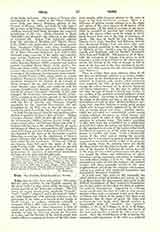

Tribe, JEWISH (Hebrew: MTH, SBT, Greek: phule, tribus)—The earlier Hebrew term rendered in our English versions by the word “tribe” is SBCH, shebet, while the term, MTH, matteh, prevails in the post-exilic writings. The two terms are nearly synonymous, signifying “branch”, “rod”, “staff”, “scepter”, and in the sense of “tribe” are used figuratively with probable reference to the derivation of the tribe as a branch of the family of Jacob (stirps), or perhaps signifying originally a company led by a chief with a staff or scepter. Arrangement by clans or tribes represents a form of social and political organization natural to Semitic nomads, as may be observed among the Bedouins of today, and the division of the Jewish people into twelve tribes is a prominent feature of the Old Testament records, while frequent allusion to the same is found in the New Testament writings. There is a difference of opinion among scholars as to the origin and nature of this most famous of all known tribal organizations. If the Biblical account of the patriarchs be accepted as personal (not tribal) history, each of the twelve tribes owed its origin to direct lineal descent from one of the sons or grandsons of Jacob. The sons of Jacob by Lia were Ruben, Simeon, Levi, Juda, Issachar, and Zabulon; and by Lia’s handmaid Zelpha, Gad and Aser, who were legally reputed according to the custom of the time as children of Lia. Jacob‘s sons by Rachel were Joseph and Benjamin, and by Rachel‘s handmaid Bala, Dan and Nephtali. The names of all of these, with the exception of Joseph, were given to their respective groups of descendants in the tribal organization, but instead of the tribe of Joseph we find in most of the lists and in the final traditional classification two tribes named after his two sons, Ephraim and Manasses.
Thus, in reality, there were thirteen tribes in all but they are habitually referred to as twelve, doubt-less because in the distribution of the land after the conquest of Palestine only twelve tribal territories were assigned, the tribe of Levi being distributed among the others because of its priestly functions and Divine inheritance. To this may be added the fact that the sons of Jacob or Israel were twelve, to say nothing of the probable artificial influence of this mystic number. According to this traditional view the origin of the tribes was due to the fact that the descendants of each of these thirteen fathers or eponyms kept together, forming as many social groups which were to some extent augmented by the inclusion of foreign slaves and wives. Another theory, which has prevailed to a considerable extent among modern scholars, interprets as tribal history and tradition much of what is told of the patriarchal eponyms in personal form. The tribes, according to this view, were not constituted by a subdivision of Israel, but rather the nation was formed originally by the aggregation of some of the earlier tribes which had themselves grown out of the union of preexisting groups of families and clans. Little is historically known of the tribal system during the nomadic period, but it is assumed on general grounds that the organization was much similar to that of the nomadic Arabs among whom the unifying forces are chiefly the blood bond and the tribal or family cult. At the time of the invasion of Palestine the nation was still in the stage of loose tribal confederation and the war was waged by tribes and subdivisions of tribes, sometimes acting separately, sometimes in combination with others (Judges, i, 3, iv, v). The process of consolidation went on after the conquest; the kindred families and clans naturally settled in the same neighborhood, and finally the complete tribal organization was evolved with territorial boundaries and independent historical traditions.
It would seem that prior to the monarchy the tribal districts varied in number and extent, as may be gathered from the discrepancies that occur in the Biblical descriptions of their respective boundaries, nor do they appear to have had any fixed or continuous political organization. Aggression by a foreign enemy would unite the clans of a tribe or even several distinct tribes under a common leader as in the case of Gideon and others of the judges; but there is no intimation that in times of peace the tribe was governed by any single chief, though mention is occasionally made of “ancients” and “princes” (Judges, x, 18; xi, 5; I Kings, iv, 3; xi, 3; II Kings, xix, 11; etc.). These were probably the heads of the clans and families of which the tribes were composed. After the establishment of the monarchy the autonomy and importance of the tribe as a political unit gradually waned, and at length the tribal names came to be little more than geographical expressions. On the other hand, veneration for the ancient tribes as social organizations with their religious and family traditions seems to have increased as time went on, and not only after the exile but also in the New Testament times we find much care displayed in recording the particular tribe or even family to which various persons are said to belong. The descendants of kings and other noted Old-Testament personages could, of course, name their tribe, but in the case of more obscure individuals it is likely that the tribal indication is inferred from the fact of family residence in a particular district of Palestine.
JAMES F. DRISCOLL

